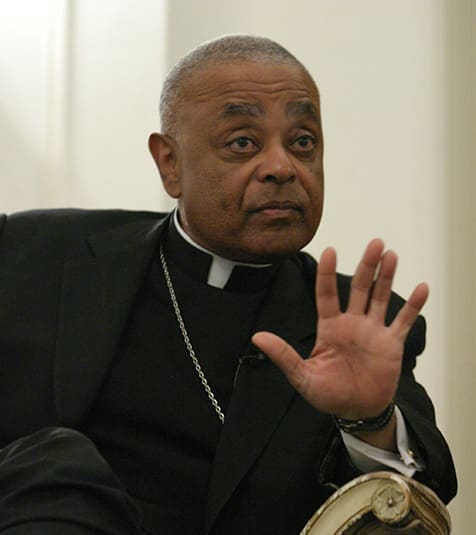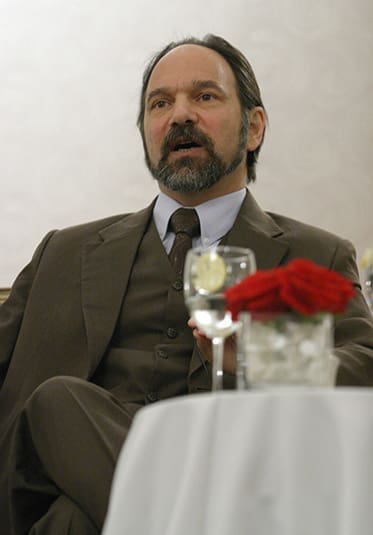 Photo By Michael Alexander
Photo By Michael AlexanderAtlanta
Interfaith Speakers Share, Explain Faith Rituals
By ANDREW NELSON, Staff Writer | Published April 9, 2009
Archbishop Wilton D. Gregory joined an interfaith panel of scholars and clergy as they shared insights on the rituals of the Jewish, Muslim and Christian faiths.
Touching on issues of language, communal prayer, and the essence of liturgy, the speakers revealed key features of the faiths, including distinctions between Catholic and Protestant Christian traditions.
Some practices in different faiths have similarities. The Catholic liturgy is rooted in Jewish table fellowship. Islam and Judaism value individual prayers in the homes of believers. Some Protestant traditions are adopting Catholic disciplines, such as fasting, that church reformers who began the denominations did away with in the 16th century.

Archbishop Wilton D. Gregory was one of four panelists during a discussion on “Rituals For One God: Liturgy And Prayer In Jewish, Christian and Muslim Traditions. Photo By Michael Alexander
Georgia is overwhelmingly a Protestant state, according to the Pew Forum on Religion & Public Life. Some 70 percent of people here worship in the Protestant tradition, followed by Catholics, with 12 percent. The Jewish and Muslim faiths make up 1 percent or less of the population.
Close to 350 women attended the 10th annual interfaith luncheon. The Atlanta chapter of the National Council of Jewish Women hosted it at The Temple, the oldest synagogue in Atlanta.
The guests were Archbishop Gregory; Rabbi Peter Berg, senior rabbi at The Temple; Alan Godlas, an associate professor of religion at the University of Georgia; Martha Moore-Keish, an assistant professor of theology at Columbia Theological Seminary, Decatur; Laurie Patton, a Candler professor of religions at Emory University.
The speakers fielded questions from Judy Marx, the executive director of the American Jewish Committee.
From the Catholic point of view, Archbishop Gregory said the church borrows much from Jewish worship. From the communal table meal to the proclamation of the Scripture, these are necessary and important components of Catholic prayer life, he said.
“As Catholics, we are deeply aware of our rootedness in Jewish ancestry,” he said.
Jewish liturgy has an outward focus, Rabbi Berg said. When people leave the service, their mission is to help make the world a better place, he said.
Its theology recognizes God’s ongoing creative acts, the revelation of God’s word in the Torah and God’s redemption of all people by freeing the Jews out of Egypt, he said.
For a Muslim service, the faithful must face toward Mecca, according to Godlas, a scholar on Islamic and Arabic studies.
God is “the sustainer of everything in existence” according to Muslim belief, he said. And gratitude is the key human quality of people toward God, he said. Muslim postures of bowing and prostrating are a reminder that without God’s constant sustenance, nothing is possible, he said.
Protestant liturgy—a broad term which covers mainstream to evangelical churches—generally favors proclaiming readings from the Bible, sacraments and “prayers in the name of Jesus,” said Moore-Keish.

Rabbi Peter Berg, left, senior rabbi at The Temple, listens as Dr. Martha Moore-Keish, assistant professor of theology, Columbia Theological Seminary, Decatur, discusses her favorite faith ritual in the Protestant Church. Photo By Michael Alexander
The sacraments of baptism and the Lord’s Supper are key parts of a Protestant liturgy, although they may not be celebrated weekly, she said.
On the issue of language, faith traditions wrestle with whether followers hold to ancient languages or use the contemporary.
Godlas said Muslims pray together in Arabic and it binds people together no matter their culture. But individuals pray on their own in their own language, he said.
For Jews, it isn’t required to pray together in Hebrew. In fact, the Reform branch of Judaism in the 19th century started as a way for Jews who didn’t speak Hebrew to worship in a common language, Rabbi Berg said. But now, Hebrew is becoming a bigger part of the service, he said.
For Catholics, Latin was the language of prayer for some 500 years, said the archbishop. The church’s prayer language evolved from Jesus’ Aramaic to Greek, a universal language in the ancient world, to Latin, which was the language of commerce, he said.
There is a “serious debate” among Catholics about language and worship, he said.
Since the Second Vatican Council, the custom has been people should have access to the language of worship, he said. The challenge is to translate the ideas expressed in the fixed language of Latin into contemporary language, he said. The archbishop compared the work to putting Shakespeare’s Elizabethan English into current day Japanese.

Dr. Alan Godlas, associate professor of religion at the University of Georgia, Athens, shares some insight into Muslim prayer traditions. Dr. Godlas teaches Islamic Studies and Arabic courses at the university. Photo By Michael Alexander
Panelists also shared the favorite ritual in their faith tradition.
Moore-Keish said the eucharistic celebration moves her. The ritual has many rich layers, from sharing food with people and the biblical level of recalling Jesus’ sacrifice to building community among believers, she said.
Godlas said Muslims have a practice of “grateful remembrance” of God’s names. It carries with it an attitude of appreciating every thought and feeling as a gift from God, he said.
The archbishop said his favorite ritual is Holy Week. The observance “really captures everything that it means to be Catholic,” he said. The week follows Jesus from the glory of Palm Sunday to Good Friday, where he is nailed to the cross, to the Easter Vigil, where newcomers join the church, and Easter, marking his new life.
“It captures the joy and the essence of our Catholic sacramental, liturgical tradition,” he said.
Rabbi Berg said his favorite moment is the blessing shared both within a congregation and in the family.
He talked about the privilege of the blessing when he and his wife hold hands over their three children and recite the prayer from the Book of Numbers: “May God bless you and keep you, may the light of God’s presence shine upon you and inspire you.”